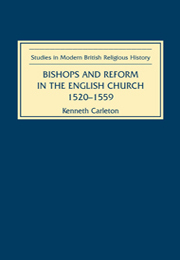Book contents
- Frontmatter
- Contents
- List of Illustrations
- Dedication
- List of Abbreviations
- Acknowledgements
- Introduction
- 1 Theologies of Episcopacy in mid-Tudor England
- 2 Models of Episcopal Office
- 3 Bishops of the English Church, 1520–1559
- 4 The Bishop and Preaching
- 5 Bishops and the Provision of Education
- 6 Prayer and Sacrifice: the Life of the Bishop
- 7 Episcopal Activity I: the Eradication of Heresy
- 8 Episcopal Activity II: the Propagation of the Ministry
- 9 Conclusion: the Old Episcopate in a New Order
- Appendix I Prosopography of the bishops in office, 1520–1559
- Appendix II The dioceses
- Appendix III The education of the bishops
- Appendix IV The bishops of Sodor and Man
- Bibliography
- Index of Scriptural References
- General Index
3 - Bishops of the English Church, 1520–1559
Published online by Cambridge University Press: 12 September 2012
- Frontmatter
- Contents
- List of Illustrations
- Dedication
- List of Abbreviations
- Acknowledgements
- Introduction
- 1 Theologies of Episcopacy in mid-Tudor England
- 2 Models of Episcopal Office
- 3 Bishops of the English Church, 1520–1559
- 4 The Bishop and Preaching
- 5 Bishops and the Provision of Education
- 6 Prayer and Sacrifice: the Life of the Bishop
- 7 Episcopal Activity I: the Eradication of Heresy
- 8 Episcopal Activity II: the Propagation of the Ministry
- 9 Conclusion: the Old Episcopate in a New Order
- Appendix I Prosopography of the bishops in office, 1520–1559
- Appendix II The dioceses
- Appendix III The education of the bishops
- Appendix IV The bishops of Sodor and Man
- Bibliography
- Index of Scriptural References
- General Index
Summary
During the period from 1520 to 1559, key changes of episcopal personnel took place which provided successive monarchs with the opportunity to change the character of the bench of bishops according to the needs of religion or state, or to reward royal servants for their part in their ruler's designs. The first decade, from 1520 to 1530, was a time of comparative stability, with few vacancies occurring for the appointment of new diocesan bishops. The second decade, particularly around the years 1532–36, was one in which most dioceses had a change of bishop. Even disregarding the few deprivations for political reasons in the early years of the 1530s, the decade is clearly one of change to an unusual extent. Whether this contributed to the nature and spread of the Henrician Reformation is a matter for some debate. Even in the latter part of the 1540s, when religious change was at its most rapid with the accession of Edward VI, changes to the episcopal bench were relatively few. It was by chance, rather than by design, that Henry was able to appoint known supporters of his supremacy to high office in his Church, though the influence of Anne Boleyn in putting forward her chaplains at a key period of change should not be forgotten. The period from the accession of Queen Mary in July 1553 to the deprivation of all but one of her bishops in the first year of the reign of Queen Elizabeth was the most unstable for the episcopate of the English Church throughout the whole early modern period up to the Civil War.
- Type
- Chapter
- Information
- Bishops and Reform in the English Church, 1520–1559 , pp. 61 - 80Publisher: Boydell & BrewerPrint publication year: 2001



